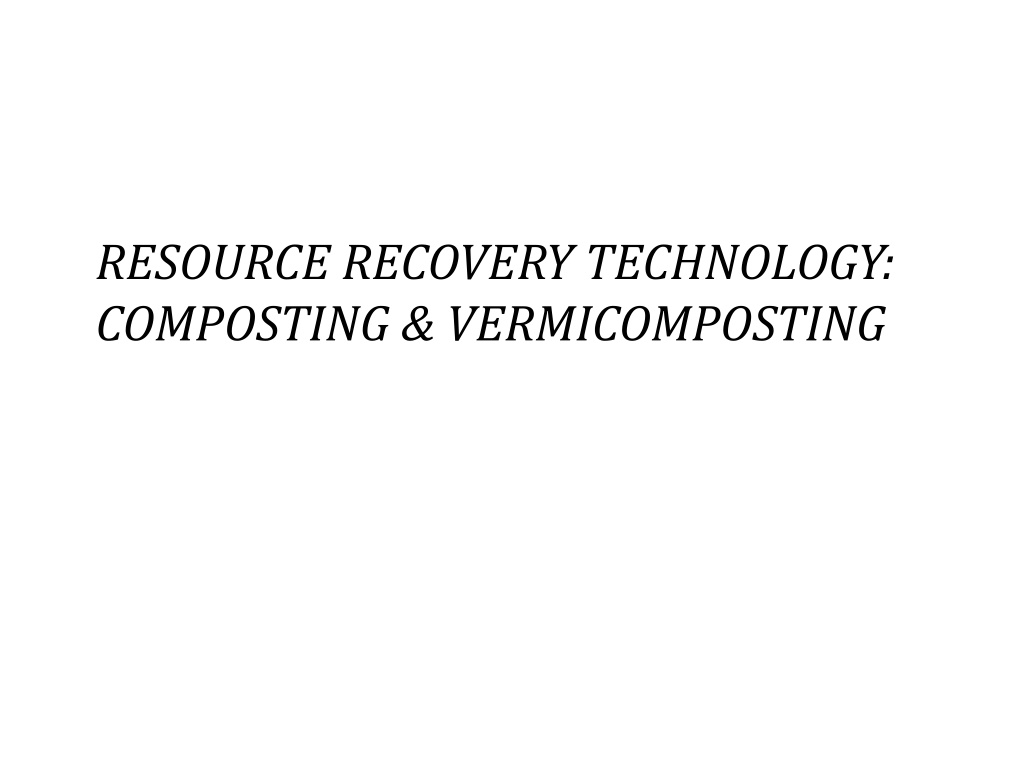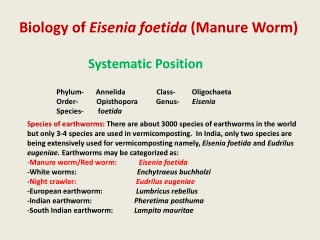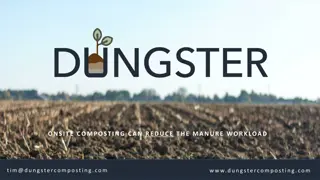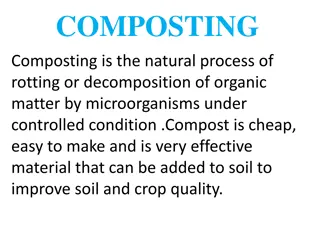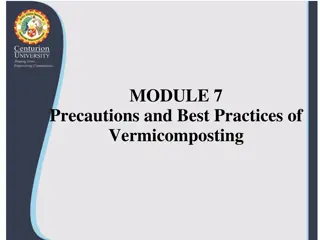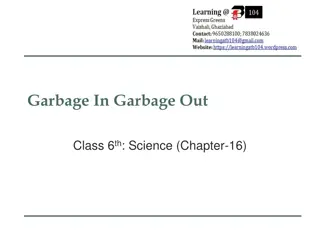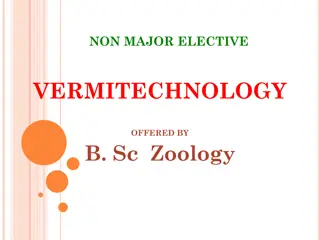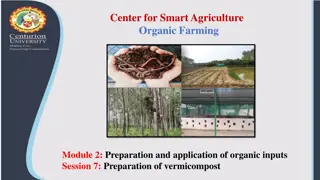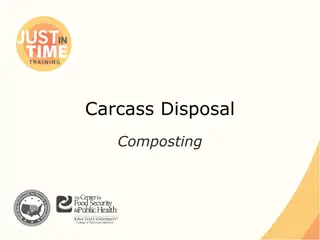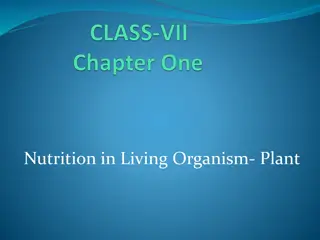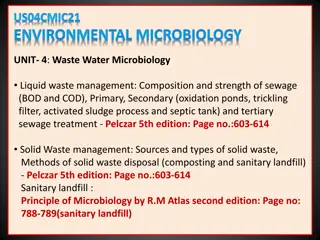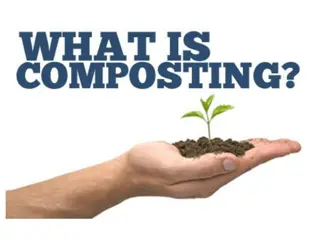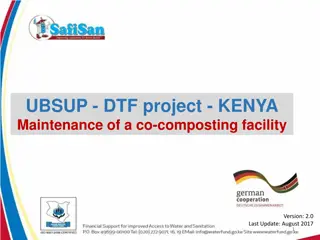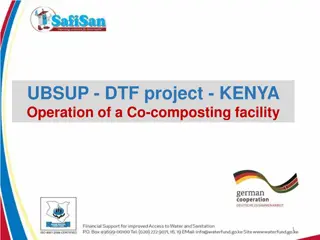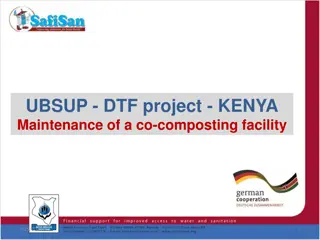Understanding Composting and Vermicomposting Technology
Composting and vermicomposting are controlled decomposition processes of organic materials, with aerobic microbes breaking down the matter in the presence of oxygen. Aerobic composting produces stable humus and helps eliminate pathogens and weed seeds. The processes involve microbial respiration, gaseous loss of CO2 and water vapor, and the conversion of nitrogen and potassium content within the compost. These methods are effective in producing nutrient-rich soil amendments while reducing waste. Learn more about the key aspects of composting and vermicomposting technology.
Download Presentation

Please find below an Image/Link to download the presentation.
The content on the website is provided AS IS for your information and personal use only. It may not be sold, licensed, or shared on other websites without obtaining consent from the author. Download presentation by click this link. If you encounter any issues during the download, it is possible that the publisher has removed the file from their server.
E N D
Presentation Transcript
RESOURCE RECOVERY TECHNOLOGY: COMPOSTING & VERMICOMPOSTING
Composting Composting is the controlled decomposition of organic materials by micro-organisms in presence (aerobic) or absence (anaerobic) of oxygen. Heat CO2 NH3 Water vapor Organic materials Nitrification Oxygen O2
Aerobic composting During microbes that thrive in the presence of O2 break down the organic mineral forms and give rise to stable humus composed humic substances. Moisture content of 50-60 % is optimum for carrying out aerobic composting. Microbes initiate the process of composting in presence of energy source (carbon), nutrients, moisture and oxygen content. aerobic composting process,
Cont- Microbial respiration can contribute to the CO2 flux in to the atmosphere. Respiration also produces heat that can derive moisture from the compost pile. Ideal temperature for active compost piles range from 50-700 C. At such high temperature, pathogens and weed seeds are destroyed.
Cont- During aerobic composting, loss of mass is largely governed by gaseous loss of CO2 and water vapor. Towards the end of the composting process, mass and volume of the initial substrate may be reduced by 50%.
Nitrogen content in compost Initially, total N-contents of the raw material (waste) are present in organic form. This organic N gets converted to NH4-N during the decomposition process. NH4-N thus produced can either get volatilize or get converted to NO3-N. As NO3-N is soluble in water, therefore, if compost leaching occurs, N loss may amount from 50%. Hence, lesser the leaching, richer the compost.
Phosphorus content in compost Loss of phosphorus is negligible in a composting system. Total P content in compost pile is present in organic form. There is no volatile pathway for P loss.
Potassium content in compost Potassium (K) is, another macro-nutrient for plant growth, present in inorganic, soluble form. It is devoid of any loss from volatilization. As there is no volatile loss of K, it tends to accumulate in the end-product of composting material. Due to its affinity to accumulate and solubilize, K-loss may occur from leaching of the compost.
Cont- N and P contents in finished compost are present in slowly biodegradable organic forms. Therefore, when compost is applied to the soil, N and P gradually become bio-available. However, as K content is already present in soluble form, so, it can directly be absorbed by the plants from compost amended soil.
Cont- Composted waste can be stored for long periods, It attracts less flies, has fewer pathogens, and weed seeds. Compost is an excellent soil conditioner. Composting reduces the mass and volume of raw materials and transforms it in to a valuable product.
Structure of a compost bin Compost bin : Perforated Width : 1-1.20 m Length: 2.5-3.0 m Height: 0.3 m Time : 3-5 months
Anaerobic composting It is the slow decay of organic matter through fermentation Unlike aerobic composting, pile will not heat up (maximum temperature 40-500C) Micro-organism (Clostridium sp., Bacteroides sp., Bacillus sp., Pseudomonas sp.) that thrive in a low-oxygen environment reduce N, P, S, or O containing compounds found in organic matter to yield humus, gases, organic acids, and nutrients.
Structure of an Anaerobic bin Anaerobic composting pits or bins should be made or located in a spot with good drainage, but not near to waterways or drainage courses. Moisture : 60-70% Time : 5-6 months- pits, 3-4 months-bins
Setting up anaerobic system Capacity: Approx. 35 gallons or more. Two bins should be used to allow for continuous composting. Lining of the bin-bottom should be bird wire in order to prevent scavengers, but to allow earthworms to enter.
Materials to an-aerobically compost Non-fatty kitchen scraps Houseplant clippings Grass clippings (small amounts) Egg shells Coffee grounds and filters Tea bags Pet and human hair Wood ash (small amounts) Untreated paper towel and tissue
Materials not to anaerobically compost . Pet or human waste (Contains pathogens and parasites) Meat and bones Animal fat or oil Dairy products Barbeque briquettes or ashes Woody yard trimmings Large quantities of leaves
How anaerobic system works Anaerobic composting nitrogen-rich materials such as non-fatty kitchen scraps and soft grass clippings. Avoid adding carbon-rich materials such as dry leaves, saw dust and woody yard waste. Don t open your anaerobic composting bin more than two times per week. More the surface area for the micro-organisms to work on, the faster the materials will decompose. works best with
Conti- Always maintain the moisture of the anaerobic compost bins. Optimum moisture is 60-70%. Time required for reaching maturity is up to 3 months. 40-500C is optimum temperature to destroy pathogens dangerous to people and pets The sign of a healthy bin is pile with a slimy consistency and slight sulfur odor. Presence of insect larvae, worms, beetles etc. indicate a productive bin.
Vermicomposting Vermicomposting is a type of composting carried out using some species of earthworms to accelerate the process. Microbial activity of earthworm gut promotes fragmentation of the consuming substrate. During this process, important plant nutrients in the organic materials (N, P, K, and Ca) are released and converted through microbial action in to soluble forms and become bio-available.
Parameter s Aerobic composting Vermicomposting Prior 6-8 During After 6-8.5 2-3 Prior 6.5-7.5 - During After 6.0-8.5 2-3 (summer) 3-5 (winter) pH Time (months) Optimum temperatu re (0C) Height of pile (m) C/N ratio Humidity 50-60 18-25, 35 (max) 0.6 4 30-35/1 30/1 40-65 20/1 30/1 40-65 Table: Comparison of different parameters between two methods of composting
Table : Comparison of various aspects of vermicomposting species of earthworms Eisenia fetida Duration of life cycle (days) 70 Growth rate (mg per worm per day) Maximum body mass (mg) 1500 Maturation attained at age (days) Start of cocoon production (days) Cocoon production (per worm per day) Incubation period (days) 23 Hatching success in water (%) Mean number of hatchlings ( per cocoon) Number of hatchlings from one cocoon Eudrillus euginae 60 12 Perionyx excavatus 46 3.5 Eisenia andrei 7 4294 40 600 21 50 35 55 46 24 0.35 1.3 1.1 Same as E. fetida 16.6 18.7 73 50 63.4 90.5 2.7 2.7 1.1 3.3 1-9 1-5 1-3 1-12
Earthworms Annelida (Latin meaning littlerings ) Body is made of about 100-150 segments. Setae or bristles present on the earthworm body segments help them to anchor and control their movement Digestive system is comprised of pharynx, esophagus, crop, gizzard and intestine. belong to the phylum
Earthworm possesses a closed circulatory system. Aortic arches, dorsal blood vessels, ventral blood vessels are the most important vessel to carry the blood supply. Respiration takes place through earthworm skin by diffusion. Moist or damp soil is important for its survival. Earthworms are hermaphrodites, but need a mate to reproduce. Cocoon i.e. fertilizedeggs develop in to young worms
Due to their anatomy, earthworms play a major role in enriching and improving soil quality. Earthworms create tunnels in soil by burrowing, helping in soil aeration, water and nutrient movement. Organic part from decaying vegetation, plants take long period of time to degrade. Earthworms feed on these materials and convert them in to more bio-available form as their casting .
Salient feature for vermicomposting bin maintenance Optimum temperature: 25-350C. Moisture content: 70- 90% Pile height: minimum 50 cm height, earthworm start consuming in a relative narrow layer of 15-25 cm.
Incubation Procedure Proper moisture Ambient Temperature (28-300C) Earthworms Drying & Sieveing Vegetable waste Dose: 10 worm/kg Incubation period: 60-90 days 28 8/28/2024
Suitable material for vermicomposing : cow manure, pig slurry, rice straw, activated sludge, paper sludge etc. During the process of incubation, the substrate undergoes two phases namely destabilization and stabilization. Under destabilization, hydrolysis takes place, whereas, mineralization takes place. under stabilization,
